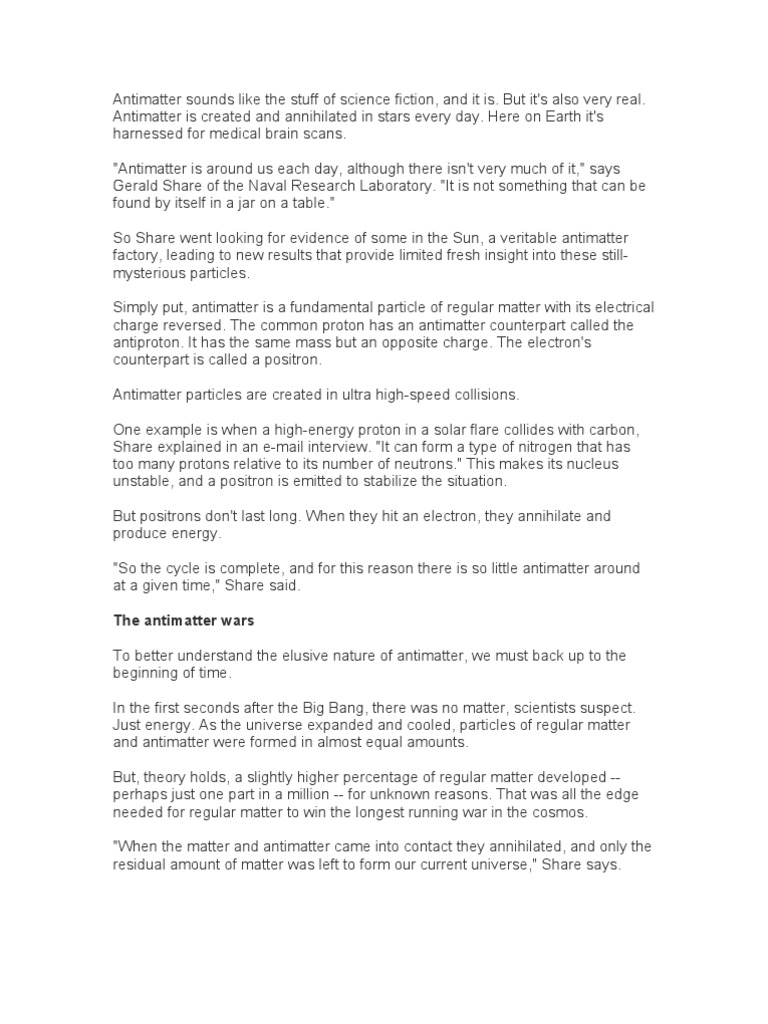Antimatter is often described as the elusive counterpart to ordinary matter, a substance that has captivated physicists and philosophers alike. This fascination raises an intriguing question: would it be possible to create a substance that could annihilate everything we know? As we delve into the enigmatic realm of antimatter, we may discover not merely theoretical constructs but also tantalizing prospects for the future of energy, propulsion, and our understanding of the universe itself.
At its core, antimatter consists of antiparticles, which are mirrored counterparts to the particles that make up ordinary matter. For instance, positrons act as the antiparticles of electrons; they possess the same mass but bear a positive charge. Similarly, antiprotons carry a negative charge while maintaining the mass of protons. This symmetrical relationship prompts a deeper inquiry into the nature of particle interactions and fundamental forces.
When particles and antiparticles meet, they engage in a dramatic dance, resulting in their mutual annihilation. This interaction releases energy in accordance with Einstein’s famed equation, E=mc2. The energy yielded from matter-antimatter annihilation is astoundingly efficient, yielding an order of magnitude greater than conventional fuels. It is, therefore, tempting to pose a challenge to contemporary energy paradigms: could antimatter be harnessed as a viable energy source? On paper, the notion appears compelling, yet the pragmatic intricacies are formidable.
Creating and storing antimatter presents a plethora of challenges. Currently, physicists can produce antiparticles in minute quantities using particle accelerators, but the scalability required for practical applications remains a significant hurdle. Antimatter production is notoriously inefficacious; it demands exorbitant energy input, which questions its utility as a sustainable energy solution. At present, the costs of producing even a gram of antimatter are staggering, running into billions of dollars. Thus, the question shifts from whether antimatter can be produced to whether it can be economically and feasibly utilized.
Beyond energy applications, antimatter has implications for advanced propulsion systems. Theoretical constructs suggest that spacecraft powered by antimatter could significantly reduce travel times within the solar system and potentially beyond. However, what technical innovations would be necessary to convert theory into operational spacecraft? The challenge transcends mere propulsion. Safety parameters, waste management, and containment techniques would require groundbreaking advancements to mitigate the inherent risks associated with antimatter.
One must also consider the philosophical and ethical ramifications of utilizing such a powerful substance. The consequences of carrying antimatter aboard a spacecraft could lead to catastrophic failures if containment measures were to be compromised. The balance between exploration and responsibility presents a unique conundrum. Are we prepared to wield such formidable power in our quest for discovery? The dialogue between scientific advancement and ethical stewardship is essential as we navigate the implications of antimatter technologies.
Moreover, the field of antimatter continues to stimulate profound scientific inquiries. The apparent asymmetry between matter and antimatter in our universe remains a confounding enigma. Current observational data suggests that matter is overwhelmingly dominant, yet theoretical models advocate for a perfect symmetry in the creation of particles and antiparticles during the Big Bang. This discrepancy has led scientists to postulate hypotheses such as CP violation and potential new physics beyond the Standard Model. Investigating antimatter could pave new avenues for exploring the fundamental laws governing the cosmos.
In contrast, as we delve into the realm of antimatter, we must embrace its complexities and the myriad questions it poses. For instance, what if the key to unlocking new realms of physics lies in our approach to antimatter? The challenge of reconciling classical mechanics with quantum phenomena epitomizes the concept of scientific inquiry itself. As the quest for understanding persists, it beckons inquisitive minds to consider whether the resolution lies within our grasp or farther afield.
The potential applications of antimatter extend even to medical technology. Positron Emission Tomography (PET), a non-invasive imaging technique, utilizes the principles of antimatter and has revolutionized diagnostic medicine. By employing positrons emitted from radioactive isotopes, clinicians can gain invaluable insights into metabolic processes. This instance illustrates how antimatter, though shrouded in mystery, has positively influenced contemporary healthcare.
In summation, the initiative to understand and manipulate antimatter intertwines aspiration with uncertainty, navigating the paradox of scientific ambition. It encapsulates a fascinating narrative: one that oscillates between potentiality and practicality, hypothesis and experimentation. As we confront the challenges of harnessing antimatter, the adventure unfolds—an expedition poised at a precipice of unprecedented discoveries. The abstract dichotomy between matter and antimatter invites further exploration, provoking profound inquiries about the very fabric of reality.
In contemplating antimatter, one must remain acutely aware that this exploration is not merely an academic endeavor; rather, it is a testament to humanity’s insatiable quest for knowledge, responsible innovation, and the relentless pursuit of understanding. In a world where every discovery reshapes our collective consciousness, the journey into the realm of antimatter is both a formidable challenge and an enthralling opportunity for future exploration. Will this enigma ultimately redefine our understanding of the universe, or is it destined to remain a tantalizing mystery? Only time and rigorous inquiry will tell.












